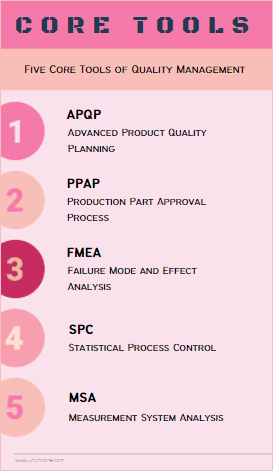In this era of competitive market leaders and increased dependency on continuous improvement, delivering “quality” products and services has become a priority. Not only do these products and services need to be of high quality, but they also need to be delivered continuously throughout the product life cycle. As a result, standards have been devised to ensure the products meet the requirements of both the organization and its customers, successfully.

Jump ahead to
Core Tools
Core Tools are standardizing tools developed by the Automotive Industry Action Group (AIAG) in collaboration with several automotive and manufacturing industries that serves the purpose of ensuring maintenance and delivery of high-quality products. The products are delivered according to the IATF 16949 standards and are believed to meet or exceed the expectations of the customers. Using the Five Core Tools, organizations were able to deliver the required quantities of quality products in a timely manner as well. Core Tools are also referred to as Automotive Quality Core Tools or simply Quality Core Tools as they originated in the automotive and manufacturing sector. Successful product delivery resulted in the usage of these core tools in other industries like defense, aerospace, pharmaceuticals industries besides the automotive or manufacturing industries.
Quality Core Tools form the building blocks of an effective and efficient Quality Management System (QMS). Delivering high-quality products, in the long run, is very important especially in the manufacturing industries. Core tools ensure that these quality standards are met by following the IATF 16949 standards of QMS. These methods are essential for planning, controlling, and maintaining product quality throughout the product development process. They help employers ensure that all the members of the organization work towards fulfilling the objectives through the Five Core Tools.
5 Core Tools of Quality

Here are the Five Core Tools of Quality Management:
- APQP (Advanced Product Quality Planning)
- PPAP (Production Part Approval Process)
- FMEA (Failure Mode and Effect Analysis)
- SPC (Statistical Process Control)
- MSA (Measurement System Analysis)
These core tools form an integral part of the quality management system and are discussed in detail in the following section.
Advanced Product Quality Planning (APQP)
APQP is one of the five Core Quality Tools that helps in creating a production control plan. The production control plan establishes the path for the planning, implementing, and verifying of the production process. The main objective of APQP is to build communication between the design team and the rest. This provides the organization the opportunity of building a cross-functional team that will meet the requirements of the project. This core tool ensures that the end-users are satisfied with the product. APQP helps in reducing the overall costs and identify problems at the earliest.
There are five phases in APQP. They are:
- Product planning and quality program definition
- Product design and development
- Process design and development
- Validation of product and process
- Launch, assessments, and continual improvement
These five phases of APQP support the quality standards of IATF 16949 and focuses on continuous improvement of the production process.
Production Part Approval Process (PPAP)
PPAP is an output of APQP. It helps in getting a better understanding of the specific requirements of manufacturers and suppliers. This standardizing tool is used in the automotive, aerospace, and manufacturing industries to communicate the designs and production processes between the two parties before, during, and after the manufacture of the products. This core quality tool has five submission levels depending on risk.
These are:
- Level 1 – Lowest risk levels reserved for simple designs
- Level 2 – Low-risk level and has limited supporting data
- Level 3 – Default risk level, requires all supporting data
- Level 4 – Customized level, used when specific changes are required
- Level 5 – Critical level, additional manufacturer-supplier collaboration required
The PPAP risk levels are submitted to ensure that the production process is carried out without fail or delays with better collaboration between the suppliers and the manufacturers.
Failure Mode and Effect Analysis (FMEA)
This Automotive Quality Core Tool is a structured approach that helps in discovering any potential failures within the production process. FMEA helps teams identify failures or defects in the production process at the earliest possible point. This ensures that the production does not get affected and the customers do not have to pay for the wasteful processes. Thus, organizations can deliver products that effectively meet their customer’s requirements. FMEA quality core tool is very reliable and offers valuable insight to ensure quality product delivery. There are two types of FMEA to detect failures in the manufacturing process.
They are as follows:
- DFMEA or Design Failure Mode and Effects Analysis – This FMEA tool is used to identify the defects in the design process. A design flaw will have an adverse effect on the final product. Thus, detecting the flaw at this stage ensures the design integrity and reliability of the product delivered.
- PFMEA or Process Failure Mode and Effects Analysis – PFMEA is used in the manufacturing process to ensure that each process is carried out without fail. It is a useful tool to maintain the quality of the production process.
Statistical Process Control (SPC)
SPC is a collection of statistical techniques used in monitoring the manufacturing process that ensures quality control. Statistical data and information are collected in the form of measurements and readings. These data are then monitored and recorded so that the production teams can measure the performance of the product in real-time. It uses the primary statistical principles of Central Tendency (Mean, Median, Mode) as well as Variation (Standard Deviation) for monitoring and controlling the quality of the product and production process.
SPC has four elements:
- Process
- Performance Information
- Action on the Process
- Action on the Output
Monitoring these elements – process, inputs, and outputs of the manufacturing process will help organizations stop the production of products with low performance that does not meet the requirements of the customers.
Measurement System Analysis (MSA)
MSA helps in determining the variation in the manufacturing process. The measurement system used in the production process must have limited variation. This ensures that the products delivered to the customers have passed the quality-control tests and will continue to deliver them in the future. Measurement systems are not absolute, these can be changed according to the requirements.
There are five parameters in MSA:
- Bias
- Linearity
- Stability
- Repeatability
- Reproducibility
There are several factors that affect the measurement and lead to variation in the production process. These can be personnel, process, equipment, and other external factors.
What is the use of Quality Core Tools?
The goal of quality management as well as these five core tools Certified Core Tools Practitoner Training is ensuring the timely delivery of high-quality products to the end-users. These automotive quality core tools are an effective way of delivering quality products in the right quantities. The Quality Core Tools assure compliance with the standards set by the automotive and manufacturing industries. They also ensure the active collaboration between different teams in the product development cycles. And helps maintain quality control throughout the supply chain process. Thus, aiding organizations across the world in delivering quality products and services to their customers.
Summary
Quality management revolves around improving processes, reducing errors, and ensuring consistent product excellence. The Core Tools of Quality Management—play a vital role in achieving these goals by identifying potential issues and strengthening quality systems. These tools help organizations enhance efficiency, ensure compliance with industry standards, and boost customer satisfaction. Mastering these five tools enables professionals to make data-driven decisions and maintain high-quality outputs across all stages of production.
Enroll in Unichrone’s Training today and prepare for Core Tools Practitioner Interview Questions build a strong foundation for your quality career success!
FAQs on Core Tools
1. What is Core Tools ?
Core Tools focuses on the five essential quality management tools— APQP, FMEA, MSA, SPC, and PPAP. These tools are used to improve manufacturing processes, ensure product quality, and maintain customer satisfaction.
2. Why are the Core Tools important in quality management?
The Core Tools are crucial because they provide a structured approach to quality planning, process control, and continuous improvement. They help organizations identify potential issues, reduce variations.
3. What are the five Core Tools of Quality Management?
The five Core Tools of Quality Management are APQP (Advanced Product Quality Planning), FMEA (Failure Mode and Effects Analysis), MSA (Measurement System Analysis), SPC (Statistical Process Control), and PPAP (Production Part Approval Process).
4. What is the difference between APQP and PPAP?
APQP (Advanced Product Quality Planning) is a framework used for planning and developing new products or processes to ensure quality from the start. PPAP (Production Part Approval Process), on the other hand, is a verification process that ensures the manufacturing process consistently produces parts that meet all customer requirements.
5. How does FMEA help in risk management?
Failure Mode and Effects Analysis (FMEA) helps identify potential failure modes in products or processes before they occur. By analyzing their causes and effects, organizations can prioritize risks, implement preventive actions, and enhance reliability, minimizing costly defects and downtime.
6. What is the purpose of MSA in quality control?
Measurement System Analysis (MSA) evaluates the accuracy, precision, and reliability of measurement systems used in quality inspections. It ensures that data collected during production is valid, consistent, and capable of detecting variations effectively.
7. How does SPC contribute to process improvement?
Statistical Process Control (SPC) uses statistical methods to monitor and control process performance. By analyzing process data, SPC helps detect trends, variations, and deviations early—enabling timely corrective actions and ensuring stable, high-quality production.
8. Is Core Tools beneficial for ISO-certified companies?
Yes. Core Tools complements ISO standards such as ISO 9001 by strengthening quality management systems. Implementing these tools ensures compliance, enhances process efficiency, and demonstrates a company’s commitment to continuous improvement.
9. How do the Core Tools improve manufacturing processes?
The Core Tools help identify potential risks, control process variations, validate measurements, and ensure product conformity.
10. What are the career benefits of learning the Core Tools of Quality Management?
Learning Core Tools equips professionals with industry-relevant skills that are highly valued in manufacturing, automotive, and engineering sectors. Certified individuals gain better career prospects and higher earning potential.



